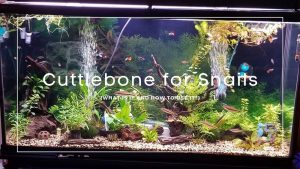If you’ve ever kept an aquarium, you know that bladder snails (Physella acuta) can be both a blessing and a curse. Most owners called them pest snails that need to be removed, while others find them to be a valuable part of their tank’s ecosystem.
These critters are often introduced to an aquarium through new aquatic plants or decorations. Once they are in the tank, they reproduce very quickly and can soon reach outbreak levels, usually referred to as a snail plague among aquarium enthusiasts. The most frustrating thing is that they are very difficult to get rid of!
However, they do have some redeeming qualities. They are avid algae eaters and good at eating uneaten fish food and breaking down fish waste, which helps to keep the tank clean and tidy. They also make a great food source for snail eaters.
Whether you introduced them to your aquarium on purpose or not, you will sooner or later end up with bladder snail eggs in your tank. How to remove or care for them? Let’s find out!
How Often Do Bladder Snails Lay Eggs?
The Bladder snail(Physa acuta) is hermaphroditic, meaning it has both male and female sex organs. This allows them to reproduce by cross-fertilization or self-fertilization. As a result, they have a very high reproductive rate.
The adult bladder snails can lay around 50 to 100 eggs each week for up to a year after sexual maturity. They can lay eggs every day during their mating season, from May to September, which coincides with the warmest months with the longest daylight hours. If you provide them with a suitable temperature, light, and abundant food, they still lay eggs even when it’s not their mating season.
What do Bladder Snail Eggs Look Like?

Bladder snail eggs are deposited in various-sized transparent and gelatinous capsules that can contain 4 to 60 eggs each. Fertilized eggs are often white or beige in color but will turn brown as they grow.
Where do Bladder Snails Lay Eggs?
These capsules are attached to inconspicuous surfaces in the aquarium, such as plants, decorations, filters, or glass, which can be hard to spot. This is one of the reasons why bladder snail populations get out of control so quickly!
How Hong Does It Take for Bladder Snail Eggs to Hatch?
The eggs take only 7 to 10 days to hatch after being laid. According to the research, the egg hatching rate can reach over 99 percent.
How to Get Rid of Bladder Snail Eggs or Babies?
So, if you didn’t deliberately introduce them to your tank and you don’t want a massive increase in their population, it’s important to remove the egg capsules as soon as you see them.
Here are some ways you should try:
Snail Eaters Fish/Snails
If you have fish or snails that eat snails, they will be more than happy to help you with the bladder snail population control. Actually, bladder snails are a good source of food for many fish because they provide a lot of protein. Moreover, the fish get a good workout from chasing them around the tank!
Here are some snail-eating fish/snails that you can consider:
- Loaches (Clown Loach, Yoyo Loach, Zebra Loach, Dwarf Chain Loach)
- Gourami
- Catfish (Cory Catfish, Striped Raphael Catfish)
- Bala Shark
- Green Spotted Puffer
- Betta Fish
- Goldfish
- South & Central American Cichlids (Apistogramma spp., Astronotus spp., Parachromis spp., Herichthys spp.)
- Assassin Snail (Anentome helena)
If you like me, a big fan of these New World Cichlids such as the oscar (A. ocellatus), Texas cichlid (H. cyanoguttatus), and Cockatoo Cichlid (A. cacatuoides), save some for them to display their natural hunting behaviors. These larger animals really enjoy bladder snails as a treat.
You can also try to get some assassin snails (Anentome helena). As their name suggests, they primarily feed on other snails. They are very effective at keeping the bladder snail babies and eggs under control.
Manual Removal
Another way to get rid of bladder snails is to manually remove them whenever you get a chance. This can be a tedious and time-consuming task!
You can use a siphon hose to suck the eggs out when you perform water changes. If you’re passing by and see the eggs, a snail catcher that is specifically designed to remove pest snails without getting your hands wet is definitely a time saver!
What’s more, it’s very easy to use and doesn’t run any risk of damaging your dedicated aquatic plants and fish like chemical solutions do. Truly a must have for fish keepers who find themselves battling snail infestations from hitchhiking eggs.
- Easily removes unwanted snails from aquarium glass
- Simply drag the snail catcher across the aquarium glass and guide the snails through the rollers and into...
- The extendable telescopic handle stops your hands from getting wet
Quarantine
Nearly 300 years ago, Benjamin Franklin said, “An ounce of prevention is worth a pound of cure.” This is especially true when it comes to taking proper care of aquariums.
The best way to deal with bladder snail eggs is to prevent them from getting into your tank in the first place, which can be done by quarantining all new plants, fish, and décor before adding them to your display tank.
It’s also an effective way to protect your tank from disease outbreaks, especially for those who keep more costly and rare fish such as discus in aquariums where the use of medications can become a big problem.
What you need to do is thoroughly inspect the new arrivals and manually remove snails and snail eggs. For live plants, you can rinse them off under running water to dislodge any unseen hitchhikers that might be attached to the leaves.
Then set up a quarantine tank and put them in it for at least two weeks. This will give you plenty of time to observe them and ensure they are bladder snail free.
Breeding Bladder Snails

While bladder snails are considered pests by many fish keepers, some people actually breed them for profit. Now your main job is to promote growth. Generally, bladder snail attains sexual maturity after 60 days of hatching.
The two main factors affecting their growth are temperature and light.
Research [Google Scholar] has shown that bladder snails can reach sexual maturity after 18 to 20 days at a water temperature of 77-82.4°F (25-28°C).
Another study found that bladder snails grew fast with light 24 hours a day at 82.4°F (25 °C), and the larva can reach sexual maturity after 40 days. But their lifespan is only about half that of bladder snails kept in the normal 12 hours of light.
Therefore, to help them reach sexual maturity as quickly as possible, you need to maintain a water temperature of 77-82.4°F (25-28°C) and provide them with plenty of light.
Conclusion
That’s all you need to know about bladder snail eggs. Bladder snails are especially difficult to remove because they are able to survive in low-oxygen environments and often hide in hard-to-reach places.
The best way to prevent a bladder snail infestation is to carefully inspect all new plants before adding them to your tank. If you do discover an infestation, there are several methods that you can use to get rid of the pests.
For breeders, maintaining the proper temperature and light conditions can help them reach sexual maturity in weeks.
Do you have any experience dealing with bladder snail eggs? Let us know in the comments below!






